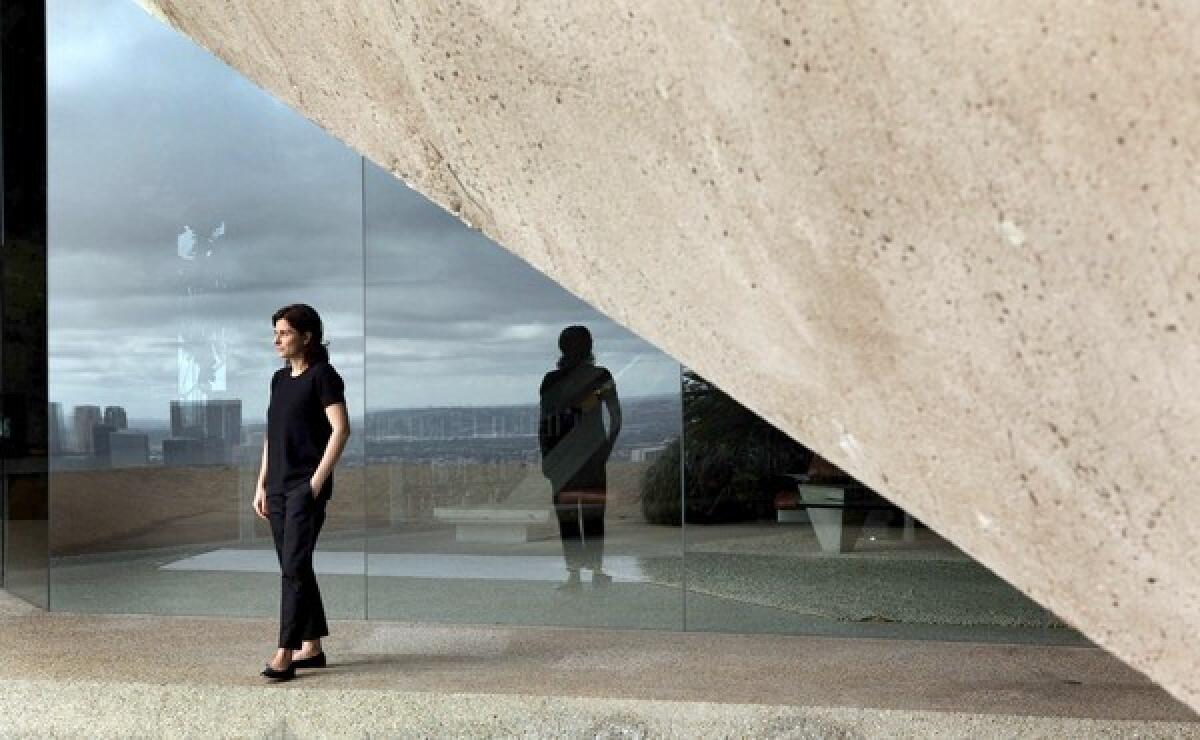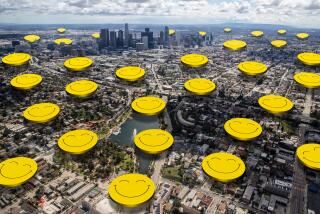At the Hammer, Luisa Lambri makes herself at home

âLos Angeles is maybe my favorite place on Earth,â says Italian photographer Luisa Lambri. âEverything I like and I need to work with happens to be there.â The artist is enthralled by the regionâs dazzling natural light but is especially fond of its architecture, in particular the classic Midcentury Modern homes that dot the hillsides. Many were designed by European expatriate architects such as Richard Neutra and R.M. Schindler who were similarly entranced by the wide-open possibilities of life in L.A.
âI can relate to that move and that kind of dream very, very much,â says Lambri, who is based in Milan but has traveled the world taking pictures inside iconic modern buildings. âIâm kind of doing the same thing with my photographs,â she says. âIâm kind of building my own house.â
One such âhouseâ is now on view at the Hammer Museum through June 13. Titled âBeing There,â the exhibition is composed of images that Lambri took in 2007 inside two local homes: Neutraâs Sten-Frenke house in Santa Monica and the Sheats-Goldstein residence in Beverly Hills by American architect John Lautner.
Signs of her presence
Most of the photographs are from the Lautner building. Designed in the early 1960s, the home is a well-known example of the architectâs dramatic, Space Age aesthetic. Yet Lambri wasnât interested in its spectacular vistas or sharply angled spaces. Instead, she looked up, focusing on skylights in the kitchen and the bathroom.
âHe had a very special, very sensitive way of working with the skylights,â she says of Lautner; he âput outside and inside together at the same time.â Indeed, on a recent visit to the house, the petite, bird-like artist seems more comfortable outside, meandering through the siteâs network of hillside stairways and pointing out the beauty of the surrounding trees. Lambri typically pays close attention to such elements. âI usually just focus on a little detail and try to spend time there and work with it,â she says. âItâs not at all about photographing everything around me.â
Usually, itâs a modest feature that catches her eye. âShe will often photograph windows, corners, half-open doors,â says Darsie Alexander, chief curator at the Walker Art Center in Minneapolis. At the Baltimore Museum of Art, Alexander curated a show of Lambriâs work in 2007. In Lambriâs photographs, she says, âthereâs always that sense of there being a presence there.â
Actual people never appear. Rather, the images evoke human occupancy with subtle details such as cabinet doors left ajar or window shutters opened at different angles. âItâs the ghost of the human being thatâs always in the photographs,â says Hammer chief curator Douglas Fogle, who organized the current exhibition, originally planned for Los Angelesâ Museum of Contemporary Art.
In most cases, the âghostâ is that of Lambri herself, who often makes small changes as she moves through the house. âEven if itâs just letting more light in a place,â she says, âthen this space somehow becomes mine.â
Depending on her agreement with the owners, she spends an hour or two alone in each house or returns over a period of several days. She works in series, shooting the same views at different times of day or in different seasons. In the exhibition brochure, Museum of Contemporary Art curator Alma Ruiz writes that Lambri heightens this effect by âmeticulously adjusting the tone and saturation of each image -- as if capturing the passage of time.â
Letting in more light
In the past, Lambri has done some of this work digitally, but the Sheats-Goldstein pictures, which feature little more than open sky and trees, are more straightforward. âWhat I did was simply just to point the camera to the sky and photograph the light. So there is nothing but light and maybe one or two very thin lines,â she says. Itâs âvery little to do with architecture. Itâs more like a sense of a space.â
âIt puts you literally in the house,â says Fogle. âYouâre looking through Luisaâs eyes, but you are there, embodied in that house.â Her work, he adds, provides a more human perspective on modern buildings that otherwise might âend up looking like museums.â
Lambriâs fascination with modern interiors was inspired by the classic midcentury photographs of Julius Shulman, whose carefully composed images of modern L.A. homes showcased flawless, pristine spaces. âI always really wondered what was happening inside and what it felt like to really actually live there,â Lambri says.
This curiosity led her to visit and photograph famous homes in Houston, Mexico City, the Czech Republic, Brazil and elsewhere. âModern homes, more than any, any home really, embody this idea of an ideal: an ideal place, an ideal home,â she says in her characteristically effusive fashion. âTheyâre always, always out of reach even when youâre actually there.â
This tension between utopian ideas and real life is at the core of Lambriâs art. Suspended between abstraction and documentary, her images can be seen as highly subjective responses to the Modern ethos of progress and innovation. This intimate quality differentiates her work from Shulmanâs and that of her European contemporaries, such as Candida HĂśfer or Thomas Struth, who also photograph buildings and interiors. Many of them were influenced by the 1970s images of German artists Bernd and Hilla Becher, who used photography to catalog different types of buildings in a dispassionate, almost scientific way.
By contrast, Lambri, who has no formal photography training, feels a greater affinity with Los Angeles artists Catherine Opie, James Welling and Uta Barth, even though their work often looks very different from her own. Another important influence was the Light and Space movement that emerged in L.A. in the 1960s. Artists such as Robert Irwin and James Turrell played with light effects and the passage of time to draw viewersâ attention to their immediate perceptions and sensations.
In this sense, L.A. is a kind of artistic home for Lambri. She first visited on a six-month residency at the MAK Center for Art and Architecture in 2002, and for each of the last few years has spent three or four months here. âHomes are sort of where you find them,â she says. âIt doesnât even need to be the place where you were born.â
âSense of finding a placeâ
For Lambri, 40, photography has always been part of this search for âhome.â
As a teenager growing up outside Milan, she was frequently allowed to travel on her own. She would take snapshots of places where she felt a personal connection, even if it was just the inside of a hotel room. In her 20s, she began to actively seek out specific buildings, but sometimes didnât even develop the film.
âWhat mattered to me then was the trip and the discovery and the sense of finding a place,â she says.
Perhaps because of this intimate connection between life and work, Lambri sees her images as a form of self-portraiture.
âI am photographing the house, but I am photographing myself being there,â she says.
More to Read
The biggest entertainment stories
Get our big stories about Hollywood, film, television, music, arts, culture and more right in your inbox as soon as they publish.
You may occasionally receive promotional content from the Los Angeles Times.










